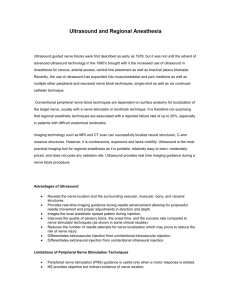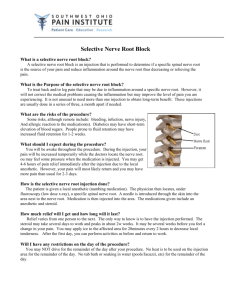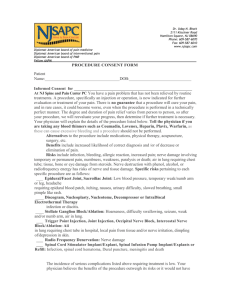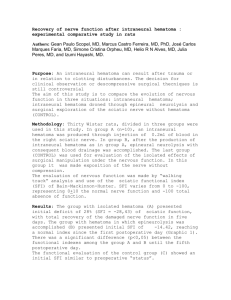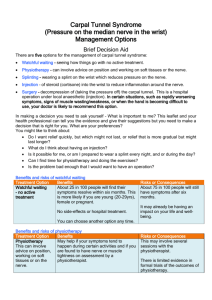Intraneural Injection – Con – Summary
advertisement
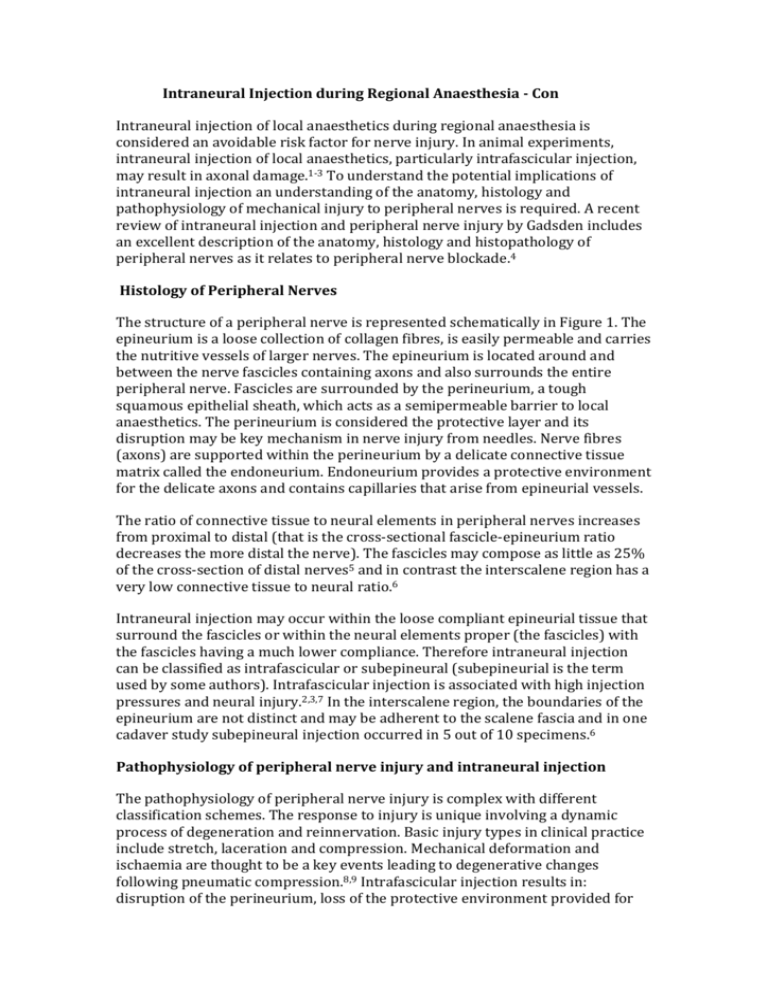
Intraneural Injection during Regional Anaesthesia - Con Intraneural injection of local anaesthetics during regional anaesthesia is considered an avoidable risk factor for nerve injury. In animal experiments, intraneural injection of local anaesthetics, particularly intrafascicular injection, may result in axonal damage.1-3 To understand the potential implications of intraneural injection an understanding of the anatomy, histology and pathophysiology of mechanical injury to peripheral nerves is required. A recent review of intraneural injection and peripheral nerve injury by Gadsden includes an excellent description of the anatomy, histology and histopathology of peripheral nerves as it relates to peripheral nerve blockade.4 Histology of Peripheral Nerves The structure of a peripheral nerve is represented schematically in Figure 1. The epineurium is a loose collection of collagen fibres, is easily permeable and carries the nutritive vessels of larger nerves. The epineurium is located around and between the nerve fascicles containing axons and also surrounds the entire peripheral nerve. Fascicles are surrounded by the perineurium, a tough squamous epithelial sheath, which acts as a semipermeable barrier to local anaesthetics. The perineurium is considered the protective layer and its disruption may be key mechanism in nerve injury from needles. Nerve fibres (axons) are supported within the perineurium by a delicate connective tissue matrix called the endoneurium. Endoneurium provides a protective environment for the delicate axons and contains capillaries that arise from epineurial vessels. The ratio of connective tissue to neural elements in peripheral nerves increases from proximal to distal (that is the cross-sectional fascicle-epineurium ratio decreases the more distal the nerve). The fascicles may compose as little as 25% of the cross-section of distal nerves5 and in contrast the interscalene region has a very low connective tissue to neural ratio.6 Intraneural injection may occur within the loose compliant epineurial tissue that surround the fascicles or within the neural elements proper (the fascicles) with the fascicles having a much lower compliance. Therefore intraneural injection can be classified as intrafascicular or subepineural (subepineurial is the term used by some authors). Intrafascicular injection is associated with high injection pressures and neural injury.2,3,7 In the interscalene region, the boundaries of the epineurium are not distinct and may be adherent to the scalene fascia and in one cadaver study subepineural injection occurred in 5 out of 10 specimens.6 Pathophysiology of peripheral nerve injury and intraneural injection The pathophysiology of peripheral nerve injury is complex with different classification schemes. The response to injury is unique involving a dynamic process of degeneration and reinnervation. Basic injury types in clinical practice include stretch, laceration and compression. Mechanical deformation and ischaemia are thought to be a key events leading to degenerative changes following pneumatic compression.8,9 Intrafascicular injection results in: disruption of the perineurium, loss of the protective environment provided for by the endoneurium and an initial rapid increase in intrafascicular pressure that may exceed the capillary pressure resulting in ischaemia and inflammation.1-4,7 Intrafascicular injection of ropivacaine is associated marked histological abnormalities comprising: inflammatory responses, haematoma, myelin damage, oedema of the perineurium and axonal destruction with Wallerian degeneration.2 A. Mechanical factors Mechanical disruption of perineurial sheath results in leakage of endoneurial contents however, this is not consistent.3 Needle trauma and other mechanical insults are associated with a variety of cellular changes (e.g. increase in neuropeptide production and dorsal horn activity).3,8 Needle tip characteristics influence the likelihood of fascicular penetration. Long bevel needles are more likely to puncture the fascicle compared with short-bevel needles and a recent cadaveric sciatic nerve study supports this (out of 134 fascicles in contact with the needle tracks, only 4 were damaged, all belonging to the sharp needle group).10 Blunt and larger needles are less likely to enter a fascicle, but if they do, they appear to cause more damage compared to a sharp needle. The severity of nerve injury after needle nerve perforation relates to the diameter of the needle.11 However, no such difference exists for regional inflammation.12 B. Toxicity of Local Anaesthetics and Additives All local anaesthetics are potentially neurotoxic.2 Exposure of peripheral nerves to local anesthetics may result in axonal damage, particularly if the solution is injected intrafascicularly, if the concentration is high, and if duration of exposure is prolonged.3 Needle penetration of a nerve may result in minimal lasting damage unless this is combined with local anesthetic administration within the nerve fascicle.3 C. Blood supply to nerves Peripheral nerves have a dual blood supply of intrinsic vessels in the endoneurium and an extrinsic plexus of vessels in the epineurial space (feeding vessels run longitudinally along the nerve) that cross the perineurium to anastomose with the intrinsic circulation. The epineurial circulation is a critical component of the overall circulation to the nerve, because its removal reduces nerve blood supply (NBF) by 50%. Neural blood flow is in the range of 9-15 ml/100gm/min (comparable to cerebral white matter).13 Local anaesthetics and adjuncts have the potential to reduce neural blood flow,13,14 and trauma from intraneural injection may compromise blood flow further. Imaging techniques Ultrasound imaging does not have sufficient axial resolution to distinguish intrafascicular from extrafascicular injection. Intraneural injection is typically demonstrated with swelling during ultrasound imaging. This is consistently observed in animal studies where intraneural injection (nerve swelling) correlates with extra-fascicular histological changes,15,16 but not functional changes.17 Clinical studies using ultrasound Intraneural injection may occur and not cause overt clinical signs of nerve injury.18-20 However, the opposite has been noted with an intraneural injection during ultrasound-guided interscalene block resulting in a severe but transitory neurologic deficit.21 Our attitudes to intraneural injection have been challenged by Bigeleisen,19 who conducted a study where nerve puncture and apparent intraneural injection during ultrasound-guided axillary block did not invariably result in neurologic injury. In this study, 50 patients were recruited, however 22/50 patients were excluded because of preoperative abnormalities in their qualitative sensory or motor examinations. In the first instance there were a very small number of patients recruited to this study (50). But a large proportion of patients were excluded and therefore the question should be asked – do the results apply to my clinical practice or just to healthy patients? We don’t know what the incidence of nerve injury is in the cohort of patients who have abnormalities of their qualitative sensory or motor testing. The study included a small sample of healthy patients receiving axillary brachial plexus block that arguably, is one of the safest in terms of nerve injury. A larger study by Liu18, recruited 257 young, healthy patients having ultrasound-guided interscalene or supraclavicular block for shoulder surgery. The incidence of unintentional intraneural injection was 17% and there was no evidence of postoperative nerve injury. What is unknown from that study is the exact site of injection: intrafascicular, extrafascicular but subepineural? Regardless, both studies are underpowered to determine incidence of nerve injury due to intraneural injection defined by nerve swelling during ultrasound-guidance.18,19 Clinical studies using nerve stimulation There appears to be no consistent level of stimulating threshold that reliably indicates intraneural placement of a needle in a wide range of anatomical locations. At the supraclavicular location, a stimulation current of 0.2 mA or less appears reliable to detect intraneural placement of the needle. However, stimulation currents of more than 0.2 and no more than 0.5 mA (a range of threshold thought to be related to efficacy) could not rule out intraneural position in that study and patients with diabetes had higher thresholds.20 During popliteal sciatic nerve block low-current stimulation was associated with a high frequency of intraneural needle placement. An injection in the intraneural space occurred in all patients who had motor-evoked response at current 0.2-0.4 mA. In addition, the absence of motor response to nerve stimulation during popliteal sciatic nerve block did not exclude intraneural needle placement.22 Definition of intraneural injection The clinical definition of intraneural injection varies from one anatomical site to another. Orebaugh reasonably points out, that the exact location of the epineurium in the interscalene region may be ill-defined, and therefore injection within the epineurium may occur commonly in this location.6 Related to this, the question, does penetration of the epineurium constitute intraneural injection during supraclavicular brachial plexus block has been debated.23 Similarly, subepineural injection was a common occurrence after nerve stimulator-guided sciatic nerve block in the popliteal fossa, yet it did not inevitably lead to neurological complications.24 However further discussion and anatomical studies are required describing anatomy in terms of intraneural and subepineural injection at different sites. It should be acknowledged that detecting intraneural injection may be unreliable related to technology, operator and patient factors. Summary and key points Intraneural injection is controversial and is not standard practice. The correlation between intraneural injection and neurological dysfunction remains unclear. Although intraneural injection may not cause nerve injury, the numbers of patients recruited to studies are inadequate to capture such an infrequent event as peripheral nerve injury. The clinical studies conducted thus far, have been on small cohorts of healthy patients. The results do not apply to patients at higher risk of perioperative nerve injury. Intraneural and subepineural injections have different implications at different anatomical locations. References 1. Selander D, Brattsand R, Lundborg G, Nordborg C, Olsson Y: Local anesthetics: importance of mode of application, concentration and adrenaline for the appearance of nerve lesions. An experimental study of axonal degeneration and barrier damage after intrafascicular injection or topical application of bupivacaine (Marcain). Acta Anaesthesiol Scand 1979; 23: 127-36 2. Whitlock EL, Brenner MJ, Fox IK, Moradzadeh A, Hunter DA, Mackinnon SE: Ropivacaine-induced peripheral nerve injection injury in the rodent model. Anesth Analg 2010; 111: 214-20 3. Hogan QH: Pathophysiology of peripheral nerve injury during regional anesthesia. Reg Anesth Pain Med 2008; 33: 435-41 4. Gadsden J, Gratenstein K, Hadzic A: Intraneural injection and peripheral nerve injury. Int Anesthesiol Clin 2010; 48: 107-15 5. Moayeri N, Groen GJ: Differences in quantitative architecture of sciatic nerve may explain differences in potential vulnerability to nerve injury, onset time, and minimum effective anesthetic volume. Anesthesiology 2009; 111: 1128-34 6. Orebaugh SL, McFadden K, Skorupan H, Bigeleisen PE: Subepineurial injection in ultrasound-guided interscalene needle tip placement. Reg Anesth Pain Med 2010; 35: 450-4 7. Hadzic A, Dilberovic F, Shah S, Kulenovic A, Kapur E, Zaciragic A, Cosovic E, Vuckovic I, Divanovic KA, Mornjakovic Z, Thys DM, Santos AC: Combination of intraneural injection and high injection pressure leads to fascicular injury and neurologic deficits in dogs. Reg Anesth Pain Med 2004; 29: 417-23 8. Burnett MG, Zager EL: Pathophysiology of peripheral nerve injury: a brief review. Neurosurg Focus 2004; 16: E1 9. Barner KC, Landau ME, Campbell WW: A review of perioperative nerve injury to the lower extremities: part I. J Clin Neuromuscul Dis 2002; 4: 95-9 10. Sala-Blanch X, Ribalta T, Rivas E, Carrera A, Gaspa A, Reina MA, Hadzic A: Structural injury to the human sciatic nerve after intraneural needle insertion. Reg Anesth Pain Med 2009; 34: 201-5 11. Steinfeldt T, Nimphius W, Werner T, Vassiliou T, Kill C, Karakas E, Wulf H, Graf J: Nerve injury by needle nerve perforation in regional anaesthesia: does size matter? Br J Anaesth 2010; 104: 245-53 12. Steinfeldt T, Werner T, Nimphius W, Wiesmann T, Kill C, Muller HH, Wulf H, Graf J: Histological analysis after peripheral nerve puncture with pencil-point or Tuohy needletip. Anesth Analg 2011; 112: 465-70 13. Myers RR, Heckman HM: Effects of local anesthesia on nerve blood flow: studies using lidocaine with and without epinephrine. Anesthesiology 1989; 71: 757-62 14. Partridge BL: The effects of local anesthetics and epinephrine on rat sciatic nerve blood flow. Anesthesiology 1991; 75: 243-50 15. Altermatt FR, Cummings TJ, Auten KM, Baldwin MF, Belknap SW, Reynolds JD: Ultrasonographic appearance of intraneural injections in the porcine model. Reg Anesth Pain Med 2010; 35: 203-6 16. Chan VW, Brull R, McCartney CJ, Xu D, Abbas S, Shannon P: An ultrasonographic and histological study of intraneural injection and electrical stimulation in pigs. Anesth Analg 2007; 104: 1281-4, tables of contents 17. Lupu CM, Kiehl TR, Chan VW, El-Beheiry H, Madden M, Brull R: Nerve expansion seen on ultrasound predicts histologic but not functional nerve injury after intraneural injection in pigs. Reg Anesth Pain Med 2010; 35: 132-9 18. Liu SS, Yadeau JT, Shaw PM, Wilfred S, Shetty T, Gordon M: Incidence of unintentional intraneural injection and postoperative neurological complications with ultrasound-guided interscalene and supraclavicular nerve blocks*. Anaesthesia 2011; 66: 168-174 19. Bigeleisen PE: Nerve puncture and apparent intraneural injection during ultrasound-guided axillary block does not invariably result in neurologic injury. Anesthesiology 2006; 105: 779-83 20. Bigeleisen PE, Moayeri N, Groen GJ: Extraneural versus intraneural stimulation thresholds during ultrasound-guided supraclavicular block. Anesthesiology 2009; 110: 1235-43 21. Cohen JM, Gray AT: Functional deficits after intraneural injection during interscalene block. Reg Anesth Pain Med 2010; 35: 397-9 22. Robards C, Hadzic A, Somasundaram L, Iwata T, Gadsden J, Xu D, SalaBlanch X: Intraneural injection with low-current stimulation during popliteal sciatic nerve block. Anesth Analg 2009; 109: 673-7 23. Morfey D, Brull R: Ultrasound-guided supraclavicular block: What is intraneural? Anesthesiology 2010; 112: 250-1; author reply 251-2 24. Sala Blanch X, Lopez AM, Carazo J, Hadzic A, Carrera A, Pomes J, Valls-Sole J: Intraneural injection during nerve stimulator-guided sciatic nerve block at the popliteal fossa. Br J Anaesth 2009; 102: 855-61


